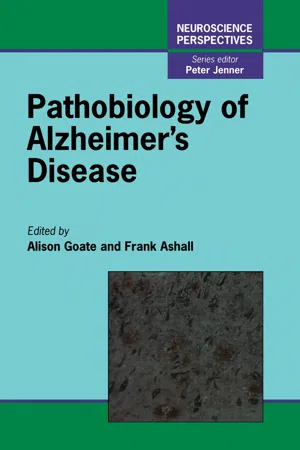
- 256 pages
- English
- PDF
- Available on iOS & Android
Pathobiology of Alzheimer's Disease
About This Book
Neuroscience Perspectives provides multidisciplinary reviews of topics in one of the most diverse and rapidly advancing fields in the life sciences.Whether you are a new recruit to neuroscience, or an established expert, look to this series for 'one-stop' sources of the historical, physiological, pharmacological, biochemical, molecular biological and therapeutic aspects of chosen research areas.The last decade has seen tremendous advances in our understanding of the pathobiology of Alzheimer's disease. These will lead to the first generation of drugs aimed at prevention rather than cure. This book covers some of the most important and exciting of these advances, with chapters written by many of the leading researchers in the field.With genetic studies as a backbone to this volume many chapters are devoted to the function and regulation of amyloid b-protein precursor (APP) and apolipoprotein E (ApoE). Other chapters describe cell biological approaches helping to piece together the link between the genetic alterations and the phenotype we call Alzheimer's disease.Although APP and its proteolytic cleavage product, amyloid b-protein, do not answer all the questions, detailed research into this system has undoubtedly increased our knowledge of the pathobiology of AD and has lead to the identification of other risk factors. Understanding the role of ApoE in the pathology of Alzheimer's disease promises to open a whole new field in AD research.* * Reviews the current knowledge of the pathogenesis of Alzheimer's Disease from a clinical perspective to a genetic and cell biological perspective* A comprehensive description of the role of amyloid B-protein precursor in Alzheimer's disease.* Up-to-date research data* Clear illustrations complement the text
Frequently asked questions
Information
Table of contents
- Front Cover
- Pathobiology of Alzheimer's Disease
- Copyright Page
- Contents
- Contributors
- Series Preface
- Preface
- Chapter 1. Plaques and tangles in Alzheimer’s disease: a historical introduction
- Chapter 2. Structure, biochemistry and molecular pathogenesis of paired helical filaments in Alzheimer’s disease
- Chapter 3. Tau proteins and their significance in the pathobiology of Alzheimer’s disease
- Chapter 4. The genetics of Alzheimer’s disease and mutations in the amyloid β-protein precursor gene
- Chapter 5. Transcriptional control of the amyloid β-protein precursor expression
- Chapter 6. Post-translational control of the amyloid β-protein precursor processing
- Chapter 7. Processing of the amyloid β-protein precursor
- Chapter 8. Neurotoxicity of amyloid β-protein and the amyloid β-protein precursor
- Chapter 9. Biological functions of the amyloid β-protein precursor
- Chapter 10. Cellular and animal models of amyloid β-protein amyloidosis
- Chapter 11. Relationship of plaques and tangles to Alzheimer’s disease phenotype
- Chapter 12. Apolipoprotein E and Alzheimer’s disease
- Index
- Color Plate Section